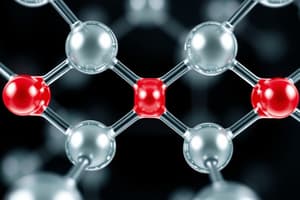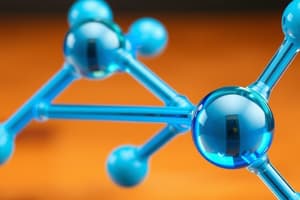Podcast
Questions and Answers
What distinguishes the repeating units of amorphous solids from crystalline solids?
What distinguishes the repeating units of amorphous solids from crystalline solids?
- Ordered units for crystalline solids
- Irregular repeating units for amorphous solids (correct)
- Regular arrangement for amorphous solids
- Symmetrical units for amorphous solids
Which property is characteristic of crystalline solids but not of amorphous solids?
Which property is characteristic of crystalline solids but not of amorphous solids?
- No specific melting point
- Phase change over a range of temperatures
- Symmetrical structure (correct)
- Irregular shape
What is a typical melting point behavior of amorphous solids?
What is a typical melting point behavior of amorphous solids?
- Melts at a specific temperature
- Does not melt under normal conditions
- Melts over a range of temperatures (correct)
- Melts at extremely high temperatures
Which of the following best describes the shape of amorphous solids?
Which of the following best describes the shape of amorphous solids?
Which of the following is an example of a crystalline solid?
Which of the following is an example of a crystalline solid?
What type of bond is formed when sodium donates an electron to chlorine?
What type of bond is formed when sodium donates an electron to chlorine?
How do hydrogen atoms bond to form a hydrogen molecule?
How do hydrogen atoms bond to form a hydrogen molecule?
Which statement about covalent bonding is true?
Which statement about covalent bonding is true?
What happens when two atoms form a covalent bond?
What happens when two atoms form a covalent bond?
Which of the following is an example of ionic bonding?
Which of the following is an example of ionic bonding?
In which type of bonding are electrons not typically shared?
In which type of bonding are electrons not typically shared?
What is the primary characteristic of a covalent bond?
What is the primary characteristic of a covalent bond?
What would best describe the bond in a diatomic hydrogen molecule (H$_2$)?
What would best describe the bond in a diatomic hydrogen molecule (H$_2$)?
What condition indicates that a solution is supersaturated?
What condition indicates that a solution is supersaturated?
What defines a saturated solution?
What defines a saturated solution?
What are extended defects in a crystal?
What are extended defects in a crystal?
Which of the following statements about crystallinity is true?
Which of the following statements about crystallinity is true?
What is true about point defects in crystals?
What is true about point defects in crystals?
What behavior is characteristic of amorphous solids?
What behavior is characteristic of amorphous solids?
At what temperature do perfect crystals theoretically exist?
At what temperature do perfect crystals theoretically exist?
What happens when more sugar is added to a saturated solution?
What happens when more sugar is added to a saturated solution?
What is a Schottky defect in a crystal lattice?
What is a Schottky defect in a crystal lattice?
Which statement describes a Frenkel defect?
Which statement describes a Frenkel defect?
In crystals, what happens to atoms during the formation of defects?
In crystals, what happens to atoms during the formation of defects?
Which of the following is true about atom positioning in crystal defects?
Which of the following is true about atom positioning in crystal defects?
What characteristic distinguishes Schottky defects from Frenkel defects?
What characteristic distinguishes Schottky defects from Frenkel defects?
How do Schottky and Frenkel defects differ in terms of atomic positions?
How do Schottky and Frenkel defects differ in terms of atomic positions?
What defines the term 'lattice site' in crystallography?
What defines the term 'lattice site' in crystallography?
Which of the following best describes the effect of defects on crystal properties?
Which of the following best describes the effect of defects on crystal properties?
Which property of powders relates to their behavior during mixing and processing?
Which property of powders relates to their behavior during mixing and processing?
What method utilizes a spatula for mixing powders?
What method utilizes a spatula for mixing powders?
Which of the following is NOT a method of mixing powders?
Which of the following is NOT a method of mixing powders?
What is the main purpose of using a containment system during milling?
What is the main purpose of using a containment system during milling?
Which characteristic of particle size describes particles with a diameter approximately 10 mm?
Which characteristic of particle size describes particles with a diameter approximately 10 mm?
What is a key factor in drying powders to ensure effective storage?
What is a key factor in drying powders to ensure effective storage?
What does particle size analysis primarily provide?
What does particle size analysis primarily provide?
Which of the following affects the compatibility of powders?
Which of the following affects the compatibility of powders?
Study Notes
Chemical Bonding - Covalent Bonding
- Covalent bonding occurs when two atoms share electrons
Crystallinity
- Amorphous solids are formed when molecules or atoms are not organized into a structured lattice
- Glass is a clear example of an amorphous solid
- The degree of crystallinity refers to how close a crystal is to perfection
- Perfect crystals only exist at absolute zero (-273.15 °C or 0 Kelvin), which has zero entropy.
- Crystals can have various defects:
- Extended defects: Defects within the individual grains of a crystal
- Point defects: Occur at isolated atomic positions within the crystal.
Amorphous Solids vs. Crystalline Solids
- Amorphous solids have irregular repeating units, no defined shape, melt over a range of temperatures, and lack symmetry.
- Examples of amorphous solids include glass and plastic.
- Crystalline solids have regular repeating units, defined shapes, melt at specific temperatures, and exhibit symmetry.
- Examples of crystalline solids include diamonds and table salt.
Crystallinity - Defects
- There are two types of defects in crystals:
- Schottky defects: Vacancies in the lattice structure caused by oppositely charged atoms leaving
- Frenkel defects: An atom or ion leaves its original lattice position and moves to an interstitial position, with the atom still residing within the crystal.
Powders: Properties, Handling, Drying, Mixing, Milling
- Powders have various properties:
- Morphology, purity, flowability, stability, particle size, uniformity, compatibility, effective surface area, solubility, appearance, colour, odour, moisture
- Drying:
- Powders can be dried using trays in an oven or air, or in low humidity environment.
- Milling:
- Milling refers to breaking down coarse particles into fine particles using mechanical force
- Proper containment systems are necessary for mitigating chemical dust release, reducing product loss and contamination
- Mixing:
- Mixing techniques include:
- Spatulation: Mixing with a spatula
- Trituration: Using a mortar and pestle
- Sifting: Passing through a sifter
- Tumbling: Using a rotating chamber
- Mixing techniques include:
Particle Size Analysis
- Particle size analysis provides quantitative data about the size, distribution, and shapes of drug components.
- Particle size characteristics range from extremely coarse (~10 mm diameter) to extremely fine (nano-sized).
Studying That Suits You
Use AI to generate personalized quizzes and flashcards to suit your learning preferences.
Related Documents
Description
This quiz explores covalent bonding and the differences between amorphous and crystalline solids. It covers key concepts such as electron sharing in covalent bonds and the structural properties of various solids. Test your understanding of these fundamental chemistry topics!




